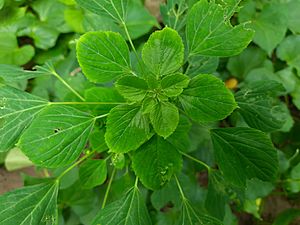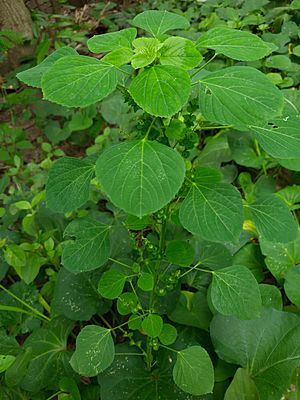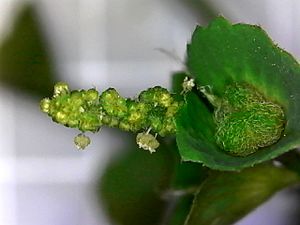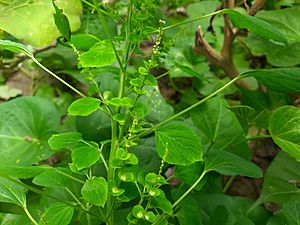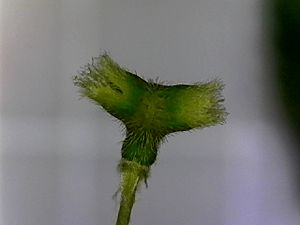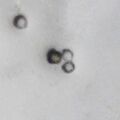Acalypha indica facts for kids
Quick facts for kids Acalypha indica |
|
|---|---|
 |
|
| Scientific classification | |
| Genus: |
Acalypha
|
| Species: |
indica
|
| Synonyms | |
|
|
Acalypha indica is a common plant known by many names like Indian Acalypha, Indian Mercury, or Indian Copperleaf. It's an annual plant, meaning it lives for about one year. This plant is special because its roots are very attractive to pet cats, similar to catnip. It also has a long history of being used in traditional medicine. You can find this plant growing all over tropical parts of the world.
Contents
What it Looks Like
Acalypha indica is an upright plant that can grow up to about 1.2 meters (4 feet) tall, but it's usually smaller. Its leaves are shaped like broad ovals. They are about 1.2 to 6.5 centimeters (0.5 to 2.5 inches) long and 1 to 4 centimeters (0.4 to 1.6 inches) wide. The edges of the leaves are wavy or toothed.
The plant has unique flower spikes that look a bit like a cat's tail. These spikes have tiny flowers. The male flowers are small and greenish-white, found at the top of the spikes. The female flowers are green and are found lower down. They are surrounded by special cup-shaped leaves called bracts.
The stem of the plant has ridges and feels a bit fuzzy. After the flowers, the plant produces small, round fruits that are about 1.5 to 2 millimeters (0.06 to 0.08 inches) in size.
Where it Grows
This plant likes to grow in places where the ground has been disturbed. You can often spot it on roadsides, in empty lots, or even in cracks in walls. It also grows on rocky hillsides, at the edges of forests, and along river banks. It prefers places that are moist and a bit shady. It can grow from sea level up to about 1350 meters (4430 feet) high.
Where it is Found Around the World
Acalypha indica is very common across the tropical parts of the Old World. This includes many countries in Africa, like Nigeria, and islands in the Indian Ocean. It's also found in India, Southeast Asia, Yemen, and Oceania. Over time, it has also been brought to the tropical areas of the New World.
How it Affects Cats
One of the most interesting things about Acalypha indica is how much domestic cats love its roots! Cats react very strongly to it, often becoming playful and excited. This effect is similar to catnip, but many people say it's even stronger. Because of this, the plant has special names in different languages that mean "cat-exciting plant" or "cat-making-sneeze." For example, in Tamil it's called kuppaimeni, and in Malay it's called pokok kucing galak, which means "excited cat tree."
Traditional Uses
This plant has been used for a very long time in traditional medicine in many parts of the world.
- In places like Madagascar and Mauritius, people have used the crushed plant or its sap to help with skin problems.
- In the Seychelles and Réunion, people make a tea from the roots to help with breathing issues like asthma. They also use it to help clean the liver and kidneys.
- A tea from the roots is also used for stomach aches.
- The sap from the leaves has been used to help people throw up if they've eaten something bad.
- In East Africa, the sap from the leaves is used for eye infections.
- In India, Acalypha indica is listed in their official medicine guide as something that can help with breathing problems like asthma and pneumonia.
Some traditional beliefs in India suggest that this plant can help make the body feel young and healthy again. People in Africa and India have also eaten the plant as a vegetable. However, it's important to be careful because the plant contains certain natural chemicals that can be harmful if not prepared correctly.
Images for kids
See also
 In Spanish: Cupamení de la India para niños
In Spanish: Cupamení de la India para niños



